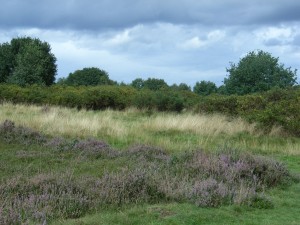The uniquely wide-ranging geology of the Geopark is directly responsible for its varied landscape character and the range of habitats and species found within it. Many areas within the Geopark are designated as biological Sites of Special Scientific Interest, Special Wildlife Sites, National Nature Reserves or Local Nature Reserves.
The Silurian Limestones of the Abberley Hills support a variety of flora including the Rock Rose, Carline Thistles, Wild Thyme and Dyers Greenweed. At least eight species of orchid, including the common spotted, bee, butterfly and pyramidal orchids thrive on the alkaline soils.

View from Abberley Hills
The Malvern Hills are home to the Skylark, Stonechat and Meadow Pipit, which are at home in the scrubby, open habitat (Malvern means bare hill). The top of the hills which is acidic grassland supports swathes of heathers and grasses. The High Brown Fritillary frequents the hills and the acidic grasslands of the adjacent Castlemorton Common. The Common is one of a few localities where there are examples of pollarded Black Poplar.
The Wyre Forest is one of the most important areas of semi- ancient woodland in the country and is home to an almost unrivalled flora and fauna. The underlying bedrock of Upper Carboniferous shales and sandstones mean the soils here are heavily acidic. The Narrow Leaved Helleborines are in rapid decline. They are a remnant of an industrial past when charcoal burning was carried out in the forest which created patches of less acidic soil suitable for this plant. An area of the forest has recently been limed to attempt to re-establish them in numbers.
Hartlebury Common is one of the most important areas of dry dwarf shrub heathland in the Geopark. It lies on wind blown sand covering two river terraces of the River Severn overlying Triassic Sandstones. Sand loving plants such as heath dog violet and tower mustard grow here. The Common is also home to all three British Newts and is an important habitat for butterflies and moths.
The Teme Valley is very important for its tufa springs that emerge from beneath the Bishops Frome limestone. The springs are rich in Calcium Carbonate which precipitates to form tufa, an important “geoindicator” of current environmental status. Streams such as the Whitbourne brook are important for their tufa dams, which support a variety of species including lichens, several types of mollusc and other invertebrates as well as numerous bird species including the Dipper and Grey Wagtail.
Specific geological sites such as disused quarries, caves and rock outcrops are also very important for their biodiversity as exposed rock surfaces support lichens and bryophytes and also provide refuge for birds and bats. The Geopark partners are full aware of this link between geodiversity and biodiversity and actively seek to conserve, enhance and promote both geodiversity and biodiversity. Quarry restoration is an important part of the work carried out by the geological trusts and sites are managed for the mutual benefit of both geology and wildlife. For example at the recently cleared Stanley Quarry, a habitat log pile was constructed, thus increasing the potential biodiversity of the quarry. Some quarry sites are deemed important enough to be nature reserves in their own right, for example Hobbs Quarry in Gloucestershire.
Biodiversity Image Gallery




